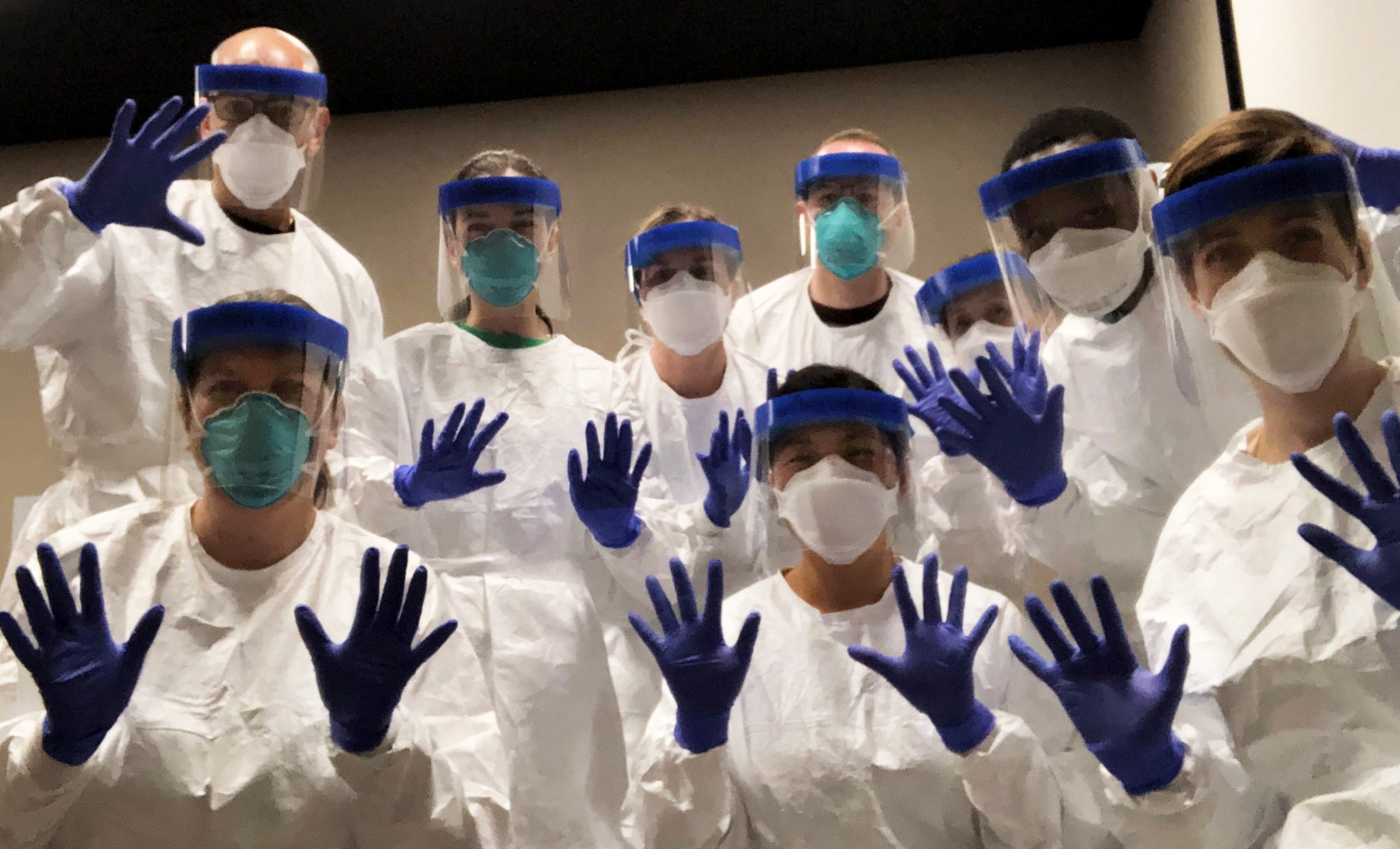Recommendations for Fully Vaccinated People
COVID-19 Homepage
Acknowledgements/References
‹View Table of Contents
The COVID-19 response has highlighted the need for a multidisciplinary public health approach—with surveillance, laboratory and health care systems/networks, and others, intersecting and coordinating as part of a larger emergency response system. This disease-specific guidance builds on the all-hazard approach for RRTs outlined in the RRT General Guidance 3 and assumes an RRT has been established using the RRT Non-Emergency Phase processes. The considerations presented, though written specifically for COVID-19, can be useful for and applied to other disease contexts. CDC staff should adapt this supplement according to a country’s emergency response context and existing resources.
Acknowledgements
This document was written and prepared by Puneet Anantharam, MPH, Ashley Greiner, MD, MPH, Adela Hoffman, MPH, and Tasha Stehling-Ariza, PhD of the CDC COVID-19 International Task Force: Emergency Response Capacity Team. Questions should be referred to RRT@cdc.gov.
We acknowledge the following contributions (in alphabetical order) supporting the CDC COVID-19 International Task Force:
- Pam Bachanas, PhD
- Amanda Balish, MPH, MS
- Jennifer Bornemann, MS
- Dante Bugli, MPH
- Leah Dick, MPH
- Danica Gomes, MD, MSc
- Margaret McCarron, MPH
- Benjamin Park, MD
- Laura Pechta, PhD, MA
- Minesh Shah, MD, MPH
- Katie Wilson, MPH
References
- Patel A, Jernigan DB. Initial Public Health Response and Interim Clinical Guidance for the 2019 Novel Coronavirus Outbreak — United States, December 31, 2019–February 4, 2020. MMWR Morb Mortal Wkly Rep 2020; 69:140–146. http://dx.doi.org/10.15585/mmwr.mm6905e1External
- Cucinotta, D., & Vanelli, M. (2020). WHO Declares COVID-19 a Pandemic. Acta Biomed, 91(1), 157-160. https://doi.org/10.23750/abm.v91i1.9397External.
- Centers for Disease Control and Prevention. (2020). CDC Methods for the Establishment and Management of Public Health Rapid Response Teams for Disease Outbreaks. Atlanta: Centers for Disease Control and Prevention. https://www.cdc.gov/globalhealth/healthprotection/errb/pdf/RRTManagementGuidance-508.pdfPdf
- Greiner AL, Stehling-Ariza T, Bugli D, Hoffman A, Giese C, Moorhouse L, Neatherlin JC, Shahpar C. Challenges in Public Health Rapid Response Team Management. Health Security. Jan 2020.S-8-S-13. http://doi.org/10.1089/hs.2019.0060External
- Hellewell, J., Abbott, S., Gimma, A., Bosse, N., Jarvis, C., & Russell, T. et al. (2020). Feasibility of controlling COVID-19 outbreaks by isolation of cases and contacts. The Lancet, 8(4), 488-496. https://doi.org/10.1016/S2214-109X(20)30074-7External
- World Health Organization. (2020). COVID-19 Strategy Update. Geneva: WHO. Retrieved 11 May 2020, from https://www.who.int/publications-detail/covid-19-strategy-update—14-april-2020External
- World Health Organization. (2020). COVID-19: Operational Planning Guidelines and COVID-19 Partners Platform to support country preparedness and response. Retrieved 28 April 2020, from https://openwho.org/courses/UNCT-COVID19-preparedness-and-response-ENExternal.
- Centers for Disease Control and Prevention. (2020). COVID-19 72-hour Response Plan Checklist. Atlanta: CDC. https://www.cdc.gov/coronavirus/2019-ncov/global-covid-19/index.html
- Centers for Disease Control and Prevention. (2020). COVID-19 Groups at Higher Risk for Severe Illness. Retrieved 11 May 2020, from https://www.cdc.gov/coronavirus/2019-ncov/need-extra-precautions/groups-at-higher-risk.html.
- Anderson, R., Heesterbeek, H., Klinkenberg, D., & Hollingsworth, T. (2020). How will country-based mitigation measures influence the course of the COVID-19 epidemic?. The Lancet, 395(10228), 931-934. https://doi.org/10.1016/s0140-6736(20)30567-5External
- Centers for Disease Control and Prevention. (2020). COVID-19 Reducing Stigma. Retrieved 11 May 2020, from https://www.cdc.gov/mentalhealth/stress-coping/reduce-stigma/index.html?CDC_AA_refVal=https%3A%2F%2Fwww.cdc.gov%2Fcoronavirus%2F2019-ncov%2Fsymptoms-testing%2Freducing-stigma.html#t1.
- Centers for Disease Control and Prevention. (2020). COVID-19 Stress and Coping. Retrieved 11 May 2020, from https://www.cdc.gov/mentalhealth/stress-coping/coping-with-stress/index.html.
- Centers for Disease Control and Prevention. (2020). COVID-19 Strategies for Optimizing the Supply of N95 Respirators. Retrieved 11 May 2020, from https://www.cdc.gov/coronavirus/2019-ncov/hcp/respirators-strategy/index.html#contingency.
- Centers for Disease Control and Prevention. (2020). Using Personal Protective Equipment (PPE). Atlanta: CDC. Retrieved 11 May 2020, from https://www.cdc.gov/coronavirus/2019-ncov/hcp/using-ppe.html
- World Health Organization. (2020). Water, sanitation, hygiene, and waste management for the COVID-19 virus. Geneva: WHO. Retrieved 11 May 2020, from https://www.who.int/publications-detail/water-sanitation-hygiene-and-waste-management-for-covid-19External
- World Health Organization. (2020). Coronavirus disease (COVID-19) outbreak: rights, roles and responsibilities of health workers, including key considerations for occupational safety and health. Geneva: WHO. Retrieved 11 May 2020, from https://www.who.int/publications-detail/coronavirus-disease-(covid-19)-outbreak-rights-roles-and-responsibilities-of-health-workers-including-key-considerations-for-occupational-safety-and-healthExternal
- Pfeiffer, Paul N, Blow, Adrian J, PhD; Miller, Erin, MS; Forman, Jane, ScD; Dalack, Gregory W, MD; et al. (2012), Peers and Peer-Based Interventions in Supporting Reintegration and Mental Health Among National Guard Soldiers: A Qualitative Study. Military Medicine; 177, 12:1471.
- Greden, J. F., Valenstein, M., Spinner, J., Blow, A., Gorman, L. A., Dalack, G. W., Marcus, S. and Kees, M. (2010), Buddy-to-Buddy, a citizen soldier peer support program to counteract stigma, PTSD, depression, and suicide. Annals of the New York Academy of Sciences, 1208: 90–97. doi:10.1111/j.1749-6632.2010.05719.
- Finnegan, A., Lauder, W., & McKenna, H. (2016). The challenges and psychological impact of delivering nursing care within a war zone. Nursing Outlook, 64(5), 450-458.
- World Health Organization. (2020). Course: RRT Training Packages for COVID-19. Retrieved 28 April 2020, from https://extranet.who.int/hslp/training/course/view.php?id=327External.
- World Health Organization. (2020). Health Security Learning Platform. Retrieved 28 April 2020, from https://extranet.who.int/hslp/training/External.
- Chen, J. (2020). Pathogenicity and transmissibility of 2019-nCoV—A quick overview and comparison with other emerging viruses. Microbes and Infection, 22(2), 69-71. https://doi.org/10.1016/j.micinf.2020.01.004External
- World Health Organization. (2020). Considerations in the investigation of cases and clusters of COVID-19. Geneva: WHO. Retrieved 12 May 2020, from https://www.who.int/publications-detail/considerations-in-the-investigation-of-cases-and-clusters-of-covid-19External
- World Health Organization. (2020). Laboratory testing for COVID-19 in suspect human cases. Geneva: WHO. Retrieved 12 May 2020, from https://apps.who.int/iris/handle/10665/331329External
- Centers for Disease Control and Prevention. (2020). Strategic Priority Infection Prevention and Control Activities for Non-US Healthcare Settings. Atlanta: CDC. Retrieved 12 May 2020, from https://www.cdc.gov/coronavirus/2019-ncov/hcp/non-us-settings/index.html
- World Health Organization. (2020). Infection prevention and control during health care when COVID-19 is suspected. Geneva: WHO. Retrieved 12 May 2020, from https://www.who.int/publications-detail/infection-prevention-and-control-during-health-care-when-novel-coronavirus-(ncov)-infection-is-suspected-20200125External
- World Health Organization. (2020). Operational considerations for case management of COVID-19 in health facility and community. Geneva: WHO. Retrieved 12 May 2020, from https://www.who.int/publications-detail/operational-considerations-for-case-management-of-covid-19-in-health-facility-and-communityExternal
- World Health Organization. (2020). Risk communication and community engagement readiness and response to COVID-19. Geneva: WHO. Retrieved 12 May 2020, from https://www.who.int/publications-detail/risk-communication-and-community-engagement-readiness-and-initial-response-for-novel-coronaviruses-(-ncov)External
- World Health Organization. (2020). Risk assessment and management of exposure of health care workers in the context of COVID-19: interim guidance, 19 March 2020. Geneva: WHO. Retrieved 11 May 2020, from https://apps.who.int/iris/handle/10665/331496External
